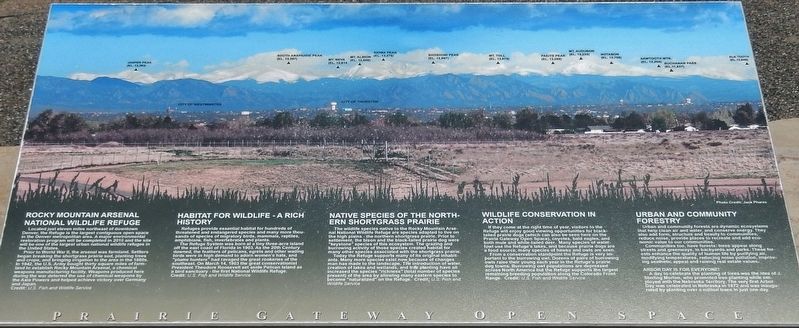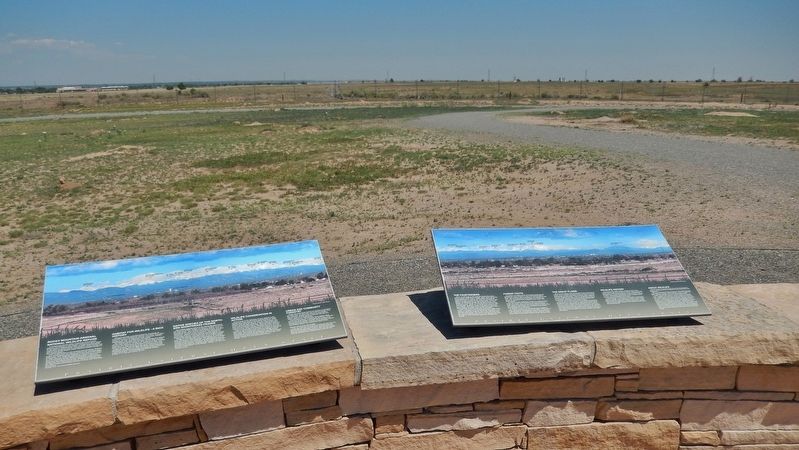Commerce City in Adams County, Colorado — The American Mountains (Southwest)
Habitat for Wildlife - A Rich History
Rocky Mountain Arsenal National Wildlife Refuge
Located just eleven miles northeast of downtown Denver, the Refuge is the largest contiguous open space in the Denver metropolitan area. A major environmental restoration program will be completed in 2010 and the site will be one of the largest urban national wildlife refuges in the United States.
Prior to World War II, the arsenal was farmland. Settlers began breaking the shortgrass prairie sod, planting trees and crops, and bringing Irrigation to the area in the 1880s. In 1942, the U.S. Army bought thirty square miles of farmland to establish Rocky Mountain Arsenal, a chemical weapons manufacturing facility. Weapons produced here during the war deterred the use of chemical weapons by the Axis Powers and helped achieve victory over Germany and Japan.
Credit: U.S. Fish and Wildlife Service
Habitat for Wildlife – A Rich History
Refuges provide essential habitat for hundreds of threatened and endangered species and many more thousands of species of migratory birds, mammals, reptiles, amphibians, fish, invertebrates and plants.
The Refuge System was born at a tiny three-acre island off the east coast of Florida in 1903. As the 20th Century dawned, the feathers of pelicans, egrets and other wading birds were In high demand to adorn women's hats, and "plume hunters" had ravaged the great rookeries of the southeast. On March 14, 1903 the great conservationist President Theodore Roosevelt set aside Pelican Island as a bird sanctuary - the first National Wildlife Refuge
Credit: U.S. Fish and Wildlife Service
Native Species of the Northern Shortgrass Prairie
The wildlife species native to the Rocky Mountain Arsenal National Wildlife Refuge are species adapted to live on the high plains - the northern shortgrass prairie. Prior to settlement, the bison and the black-tailed prairie dog were “keystone” species of this ecosystem. The grazing and burrowing activity of those species created habitat for many other species associated with the shortgrass prairie.
Today the Refuge supports many of its original inhabitants. Many more species exist now because of changes man has made to the landscape. The introduction of water, creation of lakes and wetlands, and tree planting have all increased the species "richness" (total number of species present) of the area by allowing many eastern species to become "naturalized" on the Refuge.
Credit: U.S. Fish and Wildlife Service
Wildlife Conservation in Action
If they come at the right time of year, visitors to the Refuge will enjoy good viewing opportunities for black-tailed prairie dogs
(which can also be seen here on the Prairie Gateway Open Space), coyotes, bald eagles, and both mule and white-tailed deer.
Many species of water fowl use the Refuge's lakes, and because prairie dogs are a food source, many species of hawks and owls are seen.
From a conservation standpoint the Refuge is very important to the burrowing owl. Dozens of pairs of burrowing owls raise their young each year in the Refuge’s prairie dog towns. Burrowing owl populations are depressed across North America but the Refuge supports the largest remaining breeding population along the Colorado Front Range.
Credit: U.S. Fish and Wildlife Service.
Urban and Community Forestry
Urban and community forests are dynamic ecosystems that help clean air and water, and conserve energy. They also add form, structure and beauty to communities, reduce noise, provide places to recreate and add economic value to our communities.
Communities too, have forests: trees appear along streets and greenways, in backyards and parks. These forests enhance the quality of human life by purifying air, modifying temperatures, reducing noise pollution, improving aesthetic appeal and raising real estate values.
Arbor Day is for Everyone
A day to celebrate the planting of trees was the idea of J. Sterling Morton, who promoted tree planting while employed with the Nebraska Territory. The very first Arbor Day was celebrated in Nebraska in 1872 and was inaugurated by planting over a million trees in just one day.
Erected by Commerce City, Great Outdoors Colorado, and Adams County Open Space.
Topics and series. This historical marker is listed in these topic lists: Agriculture • Animals • Environment • Horticulture & Forestry. In addition, it is included in the Former U.S. Presidents: #26 Theodore Roosevelt series list.
Location. 39° 48.736′ N, 104° 53.472′ W. Marker is in Commerce City, Colorado, in Adams County. Marker can be reached from Gateway Road, 0.7 miles north of Prairie Parkway (East 64th Avenue), on the left when traveling east. Marker is located in an open kiosk, overlooking Commerce City to the south, Denver to the west, and Thornton to the north. The kiosk is a central welcoming point for Commerce City's Prairie Gateway Open Space Park. Touch for map. Marker is in this post office area: Commerce City CO 80022, United States of America. Touch for directions.
Other nearby markers. At least 8 other markers are within 2 miles of this marker, measured as the crow flies. The Fourteeners (here, next to this marker); Early Years of Statehood (a few steps from this marker); Where's the Water? (a few steps from this marker); Rocky Mountain Arsenal National Wildlife Refuge (approx. 1.6 miles away); South Plants (approx. 1.8 miles away); Headquarters Area (approx. 2 miles away); On This Site Stood the "White House" (approx. 2 miles away); Headquarters for a New Mission (approx. 2 miles away). Touch for a list and map of all markers in Commerce City.
More about this marker. Marker is a wide composite plaque, mounted horizontally on a waist-high stone wall. This is the third of a set of four adjacent markers outlining regional history.
Credits. This page was last revised on June 28, 2018. It was originally submitted on June 27, 2018, by Cosmos Mariner of Cape Canaveral, Florida. This page has been viewed 250 times since then and 17 times this year. Photos: 1, 2. submitted on June 27, 2018, by Cosmos Mariner of Cape Canaveral, Florida. • Syd Whittle was the editor who published this page.

